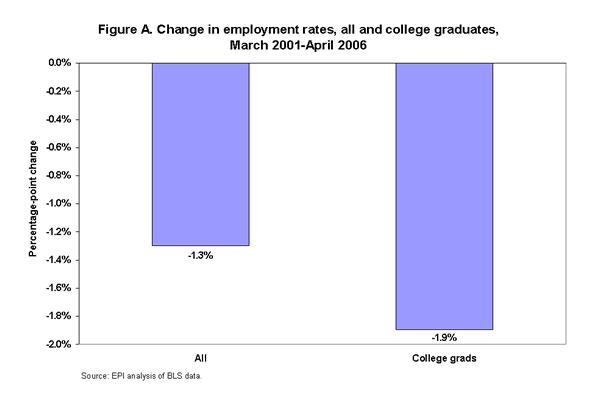See Snapshots Archive.
This Snapshot is part of a series; see also part 1, part 2 and part 3 of the series, or print the entire series.
Snapshot for May 11, 2006.
Critiquing misleading White House statements about the economy, part 4
The unemployment rate
A recent White House news release contains this claim regarding unemployment:
The unemployment rate is at 4.7%—lower than the average of the 1960s, 1970s, 1980s, and 1990s. (http://www.whitehouse.gov/news/releases/2006/04/20060411-9.html)
The unemployment rate of 4.7% in April remains slightly above the rate at the peak of the last business cycle (4.3 % in March 2001).
But the unemployment rate presents too optimistic a picture of labor market slack. Since persons not looking for work are excluded from this measure, when potential workers give up looking for work and leave the job market, the unemployment rate does not fully reflect labor market slack.
Employment rates (the share of the adult population employed) are more revealing of the job market tautness. This rate is down 1.3 percentage points of its value at the last business cycle peak in March of 2001. Notably, the employment rate is even more depressed-down 1.9 percentage points-for college graduates, a group whose job prospects are presumably not limited because of any changes in skills required in the job market. (See Figure A.)

One reason for the cyclical decline in the employment rate is the historically low rate of job creation over the recovery, even in recent months. According to research by EPI, were job creation occurring at a similar rate as the last recovery, employment growth would be about 300,000 jobs per month as opposed to the current underlying trend of about 200,000 jobs per month (though last month’s job gains were an off-trend 138,000).
Finally, as shown in the first Snapshot of this series, real earnings have been falling in recent quarters, strong evidence that we have not yet achieved a full-employment job market. In the latter 1990s, as the unemployment rate headed for 4%, real earnings grew quickly (median weekly earnings, full-time workers, were up 7%, 1995-2000). These wage trends are the most compelling argument against the White House’s claim that the job market is truly tight in historical terms.
This Snapshot was written by EPI Economist Jared Bernstein.
This Snapshot is part of a series; see also part 1, part 2 and part 3 of the series, or print the entire series.
